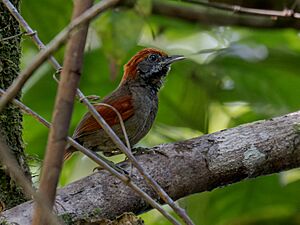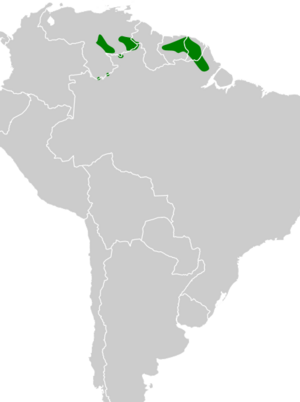McConnell's spinetail facts for kids
Quick facts for kids McConnell's spinetail |
|
|---|---|
 |
|
| Conservation status | |
| Scientific classification | |
| Genus: |
Synallaxis
|
| Species: |
macconnelli
|
 |
|
The McConnell's spinetail (Synallaxis macconnelli) is a small bird found in South America. It belongs to the ovenbird family, called Furnariidae. This bird lives in Brazil, French Guiana, Guyana, Suriname, and Venezuela.
Contents
About This Bird's Name
For a long time, scientists thought the McConnell's spinetail was the same as another bird, the Cabanis's spinetail. But now, they know it is its own unique species.
Scientists often group animals into smaller types called subspecies. Some experts, like the International Ornithological Committee, say there are two types of McConnell's spinetail. These are S. m. macconnelli and S. m. obscurior. Other groups, like the Clements taxonomy, think there is only one type.
You might notice the bird's name is spelled "macconnelli" instead of "mcconnelli". This bird was named after a person named F. V. McConnell. Even though it's a small spelling mistake, the rules for naming animals say the original spelling must be kept.
What Does It Look Like?
The McConnell's spinetail is about 15 to 17 centimeters (6 to 7 inches) long. It weighs around 18 to 20 grams (0.6 to 0.7 ounces). It is one of the darker birds in the Synallaxis group.
Both male and female birds look the same. Adult birds have a thin, light line behind their eyes. Their face is mostly gray. The top of their head and neck are a dark reddish-brown. Their back and tail feathers are dark olive-brown.
Their wings are mostly a reddish-chestnut color. The tips of their flight feathers are brownish. Their tail is dark chestnut and has pointed feathers. The feathers on their chin and throat are blackish with gray-white edges. Their belly is brownish-gray and a bit lighter in the middle.
Their eyes are chestnut-colored, their beak is black, and their legs and feet are olive green. Young birds are a little lighter than adults. Their throat has gray and white stripes, and their chest and belly are browner. The S. m. obscurior subspecies is darker and grayer than the main type.
Where Does It Live?
McConnell's spinetail lives in different areas that are not connected. The main subspecies, S. m. macconnelli, lives on high, flat-topped mountains called tepuis. You can find it in southern Venezuela, western Guyana, and far northwestern Brazil.
The S. m. obscurior subspecies lives in lower areas. These include Suriname, French Guiana, and northeastern Brazil.
This bird likes to live at the edges of evergreen forests. It can be found in both mountain forests and lowland forests. It also lives in forests that are growing back after being cut down. In French Guiana, it sometimes lives near rivers. It especially likes thick bushes and plants close to the ground.
In the tepui mountains, it lives at heights between 1,000 and 1,900 meters (3,300 to 6,200 feet). In the eastern parts of its range, it mostly lives from sea level up to about 1,000 meters (3,300 feet).
Behavior
Movement
McConnell's spinetail stays in the same area all year long. It does not migrate.
Feeding Habits
Scientists do not know much about what McConnell's spinetail eats or how it finds food. They think it eats small insects and spiders. It usually picks them off leaves and small branches. It stays about 1 to 2 meters (3 to 7 feet) above the ground. These birds are usually seen in pairs.
Reproduction and Life Cycle
The nest of a McConnell's spinetail is shaped like a ball made of sticks. It has a tube-like entrance on the side. The bird usually builds its nest in a bush, about 3 to 4 meters (10 to 13 feet) above the ground. Not much else is known about how these birds raise their young.
Sounds and Calls
The song of the McConnell's spinetail sounds like a "dry rattle." It ends with a higher-pitched sound, like "drrrrrh-Tic." Its call is a short, dry rattle, like "drrrr."
Conservation Status
The IUCN (International Union for Conservation of Nature) has listed McConnell's spinetail as a species of "Least Concern." This means it is not currently in danger of disappearing.
The bird lives across a fairly large area. Scientists do not know exactly how many McConnell's spinetails there are, but they believe the population is stable. There are no major threats to this bird right now. It is considered fairly common, but it can be hard to find in some places. Unlike many other spinetail birds, it prefers true forest areas and does not usually live in places where forests have been heavily cut down.


